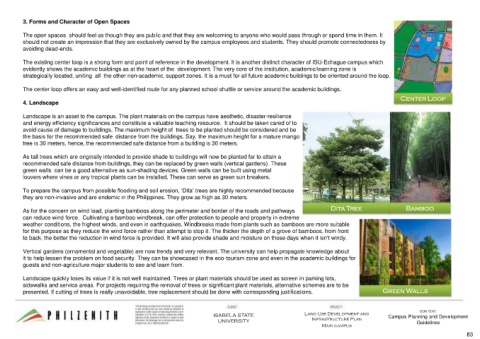Page 83 - ISU Echague LUDIP
P. 83
3. Forms and Character of Open Spaces
The open spaces should feel as though they are public and that they are welcoming to anyone who would pass through or spend time in them. It
should not create an impression that they are exclusively owned by the campus employees and students. They should promote connectedness by
avoiding dead-ends.
The existing center loop is a strong form and point of reference in the development. It is another distinct character of ISU-Echague campus which
evidently shows the academic buildings as at the heart of the development. The very core of the institution, academic/learning zone is
strategically located, uniting all the other non-academic, support zones. It is a must for all future academic buildings to be oriented around the loop.
The center loop offers an easy and well-identified route for any planned school shuttle or service around the academic buildings.
Center Loop
4. Landscape
Landscape is an asset to the campus. The plant materials on the campus have aesthetic, disaster-resilience
and energy efficiency significances and constitute a valuable teaching resource. It should be taken cared of to
avoid cause of damage to buildings. The maximum height of trees to be planted should be considered and be
the basis for the recommended safe distance from the buildings. Say, the maximum height for a mature mango
tree is 30 meters, hence, the recommended safe distance from a building is 30 meters.
As tall trees which are originally intended to provide shade to buildings will now be planted far to attain a
recommended safe distance from buildings, they can be replaced by green walls (vertical gardens). These
green walls can be a good alternative as sun-shading devices. Green walls can be built using metal
louvers where vines or any tropical plants can be installed. These can serve as green sun breakers.
To prepare the campus from possible flooding and soil erosion, ‘Dita’ trees are highly recommended because
they are non-invasive and are endemic in the Philippines. They grow as high as 30 meters.
As for the concern on wind load, planting bamboos along the perimeter and border of the roads and pathways Dita Tree Bamboo
can reduce wind force. Cultivating a bamboo windbreak, can offer protection to people and property in extreme
weather conditions, the highest winds, and even in earthquakes. Windbreaks made from plants such as bamboos are more suitable
for this purpose as they reduce the wind force rather than attempt to stop it. The thicker the depth of a grove of bamboos, from front
to back, the better the reduction in wind force is provided. It will also provide shade and moisture on those days when it isn't windy.
Vertical gardens (ornamental and vegetable) are now trendy and very relevant. The university can help propagate knowledge about
it to help lessen the problem on food security. They can be showcased in the eco-tourism zone and even in the academic buildings for
guests and non-agriculture major students to see and learn from.
Landscape quickly loses its value if it is not well maintained. Trees or plant materials should be used as screen in parking lots,
sidewalks and service areas. For projects requiring the removal of trees or significant plant materials, alternative schemes are to be
presented. If cutting of trees is really unavoidable, tree replacement should be done with corresponding justifications. Green Walls
CONTENT:
ISABELA STATE Land Use Development and Campus Planning and Development
UNIVERSITY Infrastructure Plan Guidelines
Main campus
83

